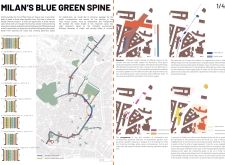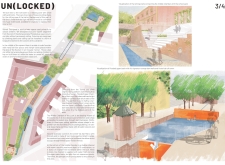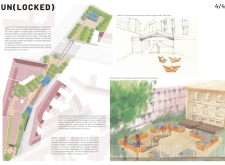5 key facts about this project
At its core, the project emphasizes the fusion of the "blue spine" and "green spine," wherein water features and landscaped green areas create a cohesive network throughout the city. The design not only aims to improve aesthetic value but also seeks to facilitate social interaction and environmental education. Each designated area along the canal showcases different uses, including parks, public gathering spaces, and transportation routes, all carefully organized to enhance user experience and accessibility.
The architectural elements of this project are designed with meticulous attention to detail. The grotto-like tunnel is one of the more unique features, offering an immersive experience that simulates a natural setting. This tunnel not only adds aesthetic depth but also incorporates functional aspects such as a drip irrigation system that nourishes the waterway. Complementing the tunnel is the mirror water basin, which acts as both an aesthetic focal point and a water treatment solution, emphasizing the project's dual commitment to beauty and functionality.
Distinctive sculptural fountains are incorporated throughout the site, inviting residents to engage with the water features. These elements are not merely decorative but serve educational purposes, raising awareness about water management and environmental stewardship. Additionally, the design includes interactive public areas with seating made from locally sourced materials, promoting community engagement and interaction.
The project exemplifies a unique design approach by honoring Milan's historical context while prioritizing sustainability and modern functionality. By bridging the gap between urban life and nature, this design addresses contemporary challenges in urban planning and environmental management. The thoughtful integration of natural elements into the urban core presents an inviting environment that serves both ecological and social needs.
The architectural creativity displayed in the project encourages exploration and invites further investigation into various aspects such as architectural plans, architectural sections, and architectural designs. Readers interested in understanding the innovative ideas behind this project are encouraged to delve deeper into the presentation to explore its many features and the underlying principles that guide its design. The interplay of architecture and nature in this project provides a valuable perspective on contemporary urban development.


























